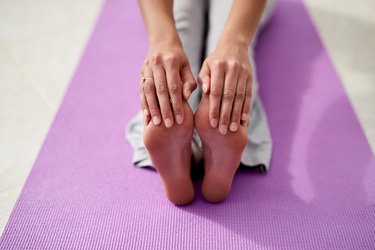
Chances are, you don't think much about your tailbone — that is, until you injure it. Although it's a very small bone, tailbone pain can be severe. If your tailbone hurts, you might be hesitant to be active, but there are exercises that you can perform safely.
Tip
Exercises that involve prolonged sitting or standing can aggravate tailbone pain. However, gentle stretching can improve mobility as your tailbone heals.
Video of the Day
Causes of Tailbone Pain
Tailbone pain — also called coccydynia — is most commonly caused by trauma, such as a fall or childbirth. However, in some cases, tailbone pain seems to come out of nowhere.
Video of the Day
The coccyx, or tailbone, sits at the very end of your spine and is connected to muscles, ligaments and tendons. Injury to any of these structures can also cause tailbone pain.
Read more: Tailbone Pain from Weightlifting
Perform Tailbone Stretches
Gentle tailbone stretches can improve flexibility and relieve discomfort as your coccyx heals. Stand with your feet together. Keeping your knees straight, slowly bend over and reach for your toes. Stop when you feel a stretch in your lower back.
Hold this position for 10 seconds. Then slowly stand back up. Repeat five times, twice each day while you are experiencing tailbone pain. Do not stretch to the point of pain — this can cause further injury.
Stretch Your Groin
If your tailbone hurts after sitting for long periods of time, try the kneeling groin stretch. Stand with your feet staggered, one in front of the other. Place your back knee on the floor and bend your front knee.
Keeping your chest up, slowly shift your weight forward toward the front leg until you feel a stretch in your groin. Hold for 10 to 20 seconds; then relax. Repeat three times on each leg.
Read more: Exercises for Tailbone Pain
Avoid These Exercises
Be aware of exercises to avoid with tailbone injury. Sitting increases pressure on the tailbone, so avoid exercises like cycling or rowing while you are healing, Instead, try walking for short periods of time, several times per day.
Avoid jogging or other high-impact exercises with tailbone pain. This jarring movement can stress muscles and ligaments in your pelvis and delay healing. Consider using an elliptical or swimming as alternative low-impact activities.
Consider Additional Interventions
According to a 2014 study published by The Ochsner Journal, 90 percent of cases of tailbone pain are successfully treated with conservative treatment. In addition to exercise, other interventions can reduce pain as your bone is healing:
- Wedge-shaped cushions are available to relieve pressure on your coccyx in a seated position. This can be particularly helpful if you have a sedentary job. Heat and cold are both effective for temporarily relieving pain in your tailbone.
- Over-the-counter anti-inflammatory and pain medications can reduce tailbone pain. Check with your doctor to be sure these meds are safe for you.
- Medical interventions can also include steroid injections, and as a last resort, surgery.
If home remedies are not helping, consider seeing a physical therapist for additional interventions such as massage and manual mobilization.
Is this an emergency? If you are experiencing serious medical symptoms, please see the National Library of Medicine’s list of signs you need emergency medical attention or call 911.